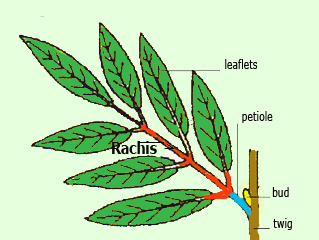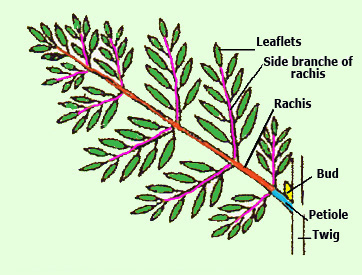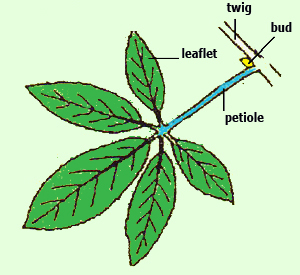intro | introduction | complexity | attachment | margins | shapes | venation | twigs | quiz
- page 2 -
Complexity
You only have to learn 4 types of complexity: 1 simple leaf and 3 compound leaves.
Simple leaves
Simple leaf.

A simple leaf consists of one single blade (dark green) and a petiole, the botanical term for leaf stalk (blue), with which it is connected to the twig. Where the petiole is connected to the twig you will find a bud (yellow).
Compound leaves.
A Compound leaf doesn't have a single blade, but has separate leaflets. We call a leaf
that has separate leaflets a compound leaf. There are many different compound leaves
and you have to learn 3.
A once pinnately compound leaf
(also called single pinnately compound)
A once pinnately compound leaf has leaflets
(green) which are attached to the rachis (red) and not directly to the twig. The rachis (red) is the extension
of the petiole (blue).
The leaflets (green), rachis (red) and the petiole (blue) form together one compound" leaf
As with a single leaf, the bud grows where the petiole (blue) is attached to the twig. There are no buds where the leaflets are attached to the rachis.
This leaf is called pinnately compound, because the leaflets grow opposite to each other on the rachis (arranged like the parts of a feather).

Twice pinnately compound leaf
(also called double pinnately compound)
A twice pinnately compound leaf also has leaflets (green), but they are attached to the side branches (pink) of the rachis (red).
Again, the leaflets (grren), rachis (red) the side branches of the rachis (pink) and the petiole (blue) form together one "compound" leaf.
As with a single leaf, the bud (yellow) grows where the petiole is attached to the twig. There are no buds where the leaflets are attached to the side branches of the rachis and no buds where the
side braches are connected to the rachis.
Palmately compound leaf.

A palmately compound leaf also has leaflets (green) but they are all attached at the end of the petiole (blue).
The leaflets (green) together with the petiole (blue) form one "compound" leaf.
As with all leaves, the bud {yellow) can be found where the petiole is attached to the twig.